Q&A Special: Ballerina Sylvie Guillem | reviews, news & interviews
Q&A Special: Ballerina Sylvie Guillem
Q&A Special: Ballerina Sylvie Guillem
The great dancer talks about her passion for Japan, soft-top English cars and why some people are stars but not others
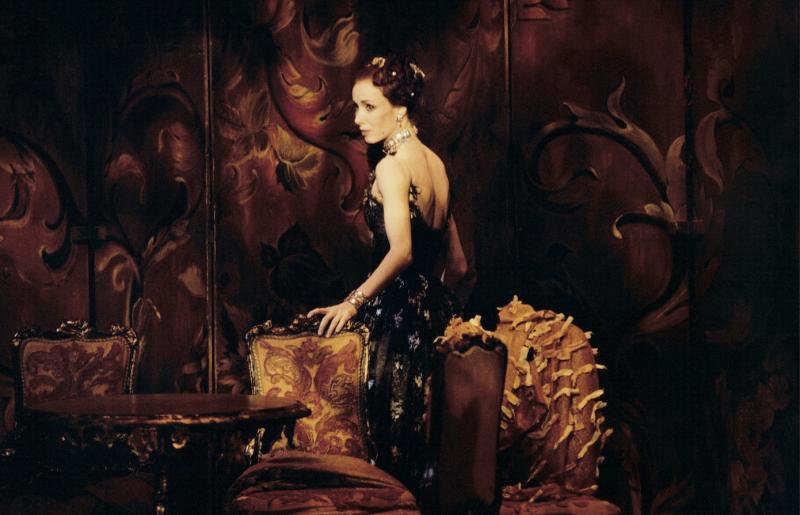
The star ballerina Sylvie Guillem was rehearsing in London when she heard about the cataclysmic Japanese earthquake last spring, and the devastating tsunami in its aftermath. It was an apocalyptic blow that she felt personally.
Her current show, 6000 Miles Away, just created and shown at Sadler’s Wells, became a calling card for her beloved Japan but next month will be the first time that she has been able to tour to the damaged country whose story has slipped far away from headlines, despite tens of thousands of people still remaining displaced six months later.
For a celebrity of the stage who can be just as easily found featured as a photographer in a super-chic Milan gallery or modelling Issey Miyake fashion, Guillem is liberatingly candid and straightforward. There are no pretences to her. It’s a characteristic of “Miss No”, as she was dubbed years ago when she arrived at the Royal Ballet, that she is so visibly delighted by applause and audience reaction. While Margot Fonteyn’s curtain calls were beautifully sculpted performances, Guillem’s are natural, unaffected, grateful to be loved, an impression that doesn't look faked.
Her website features cascades of happy snaps of trips to Switzerland, Ethiopia, New York, Singapore, Italy, New Zealand, which could have been taken by any eager tourist: making shadows on snow, marvelling at a garden’s proportions, getting a chef to pose after having a good meal out. For someone who inspires awe on stage, the personality shown in the website is a complete surprise. The legendary diva is actually a gamine girl with an appetite for life and jokes with her fans, constantly laughing, addicted to her camera, wearing silly hats for kooky pics, wearing make-up only for those stage performances in which she transfigures herself into another being, gloriously blessed, ferociously talented, ferociously serious about how she uses her talent.
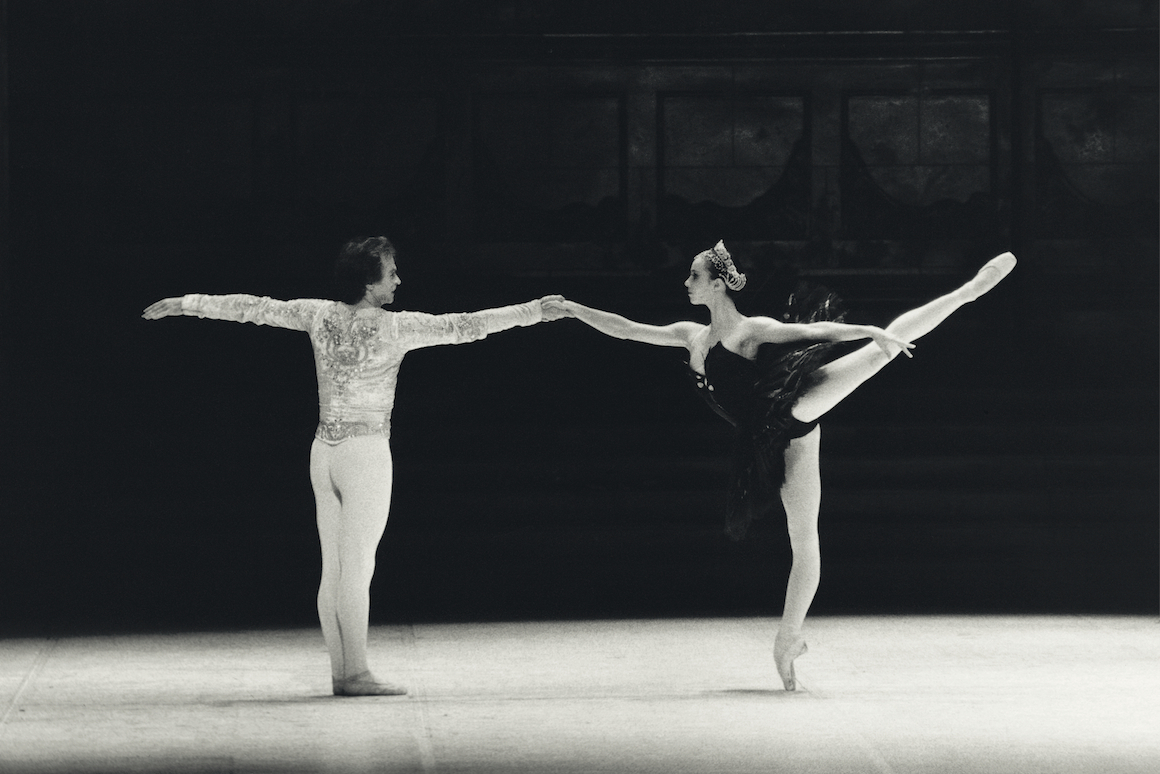 It is often told how Guillem had been a talented, fearless gymnast when she joined the ballet school, and briskly eclipsed her generation. Rudolf Nureyev, the legendary dancer who was now Paris Opera Ballet’s director, hired her when she was 16 and officially ranked her as an étoile (star) only three years later (the two pictured left © Gilles Tapie/Invitation). In Paris she danced a vast repertoire from classics such as Raymonda and The Sleeping Beauty to modern ballets by Balanchine, William Forsythe, Maurice Béjart, Robert Wilson and Nureyev himself, but it was not enough. Four years later she negotiated a guest contract with the Royal Ballet in London that would allow her to take all invitations offered from abroad too.
It is often told how Guillem had been a talented, fearless gymnast when she joined the ballet school, and briskly eclipsed her generation. Rudolf Nureyev, the legendary dancer who was now Paris Opera Ballet’s director, hired her when she was 16 and officially ranked her as an étoile (star) only three years later (the two pictured left © Gilles Tapie/Invitation). In Paris she danced a vast repertoire from classics such as Raymonda and The Sleeping Beauty to modern ballets by Balanchine, William Forsythe, Maurice Béjart, Robert Wilson and Nureyev himself, but it was not enough. Four years later she negotiated a guest contract with the Royal Ballet in London that would allow her to take all invitations offered from abroad too.
In London she added the dramatic roles of the British geniuses Kenneth MacMillan and Frederick Ashton to her CV, and from that source sprang her later evolution into the contemporary London creations of Russell Maliphant, the Ballet Boyz and Akram Khan, a significant step for her but also for the perception of ballet itself as a growing, absorbent modern form of British theatre.
Now aged 46, she has an éclat that stretches from haute couture fashion and modern visual arts to film, television and even gardening. With her lanky body and elfin face, she’s always been a dream for Japanese couturiers to dress in their voluminous, asymmetric, angular shapes far from the rococo femininity of the tutus of Princess Aurora or Giselle, the bodices and jewels for Manon or Marguerite.
I've long been curious to know more about Guillem's love of Japan and how it complements a career forged and refined in the opulence of a French theatrical art form. We met on Saturday in a London hotel. She talked revealingly about her liking for people who take responsibility for mistakes, about soft-top cars, animal conservation, and why some dancers can’t help being stars. And her dislikes - the nuclear industry, being photographed by strangers, and working with people who don’t want to learn.
When people say to you, 'I’d give you a part of my life so that you can keep on dancing,' that’s a powerful thing to hear
ISMENE BROWN: What were you doing when you heard about the earthquake in Japan?
SYLVIE GUILLEM: We were in the studio here creating the William Forsythe work, Re-array [just seen at Sadler's Wells]. It was the last day of the rehearsal, the next day we were taking the plane, so we were following the news on the internet, the airport TV and then in France. It’s why I called the show 6000 Miles Away - it's the distance between them and us.
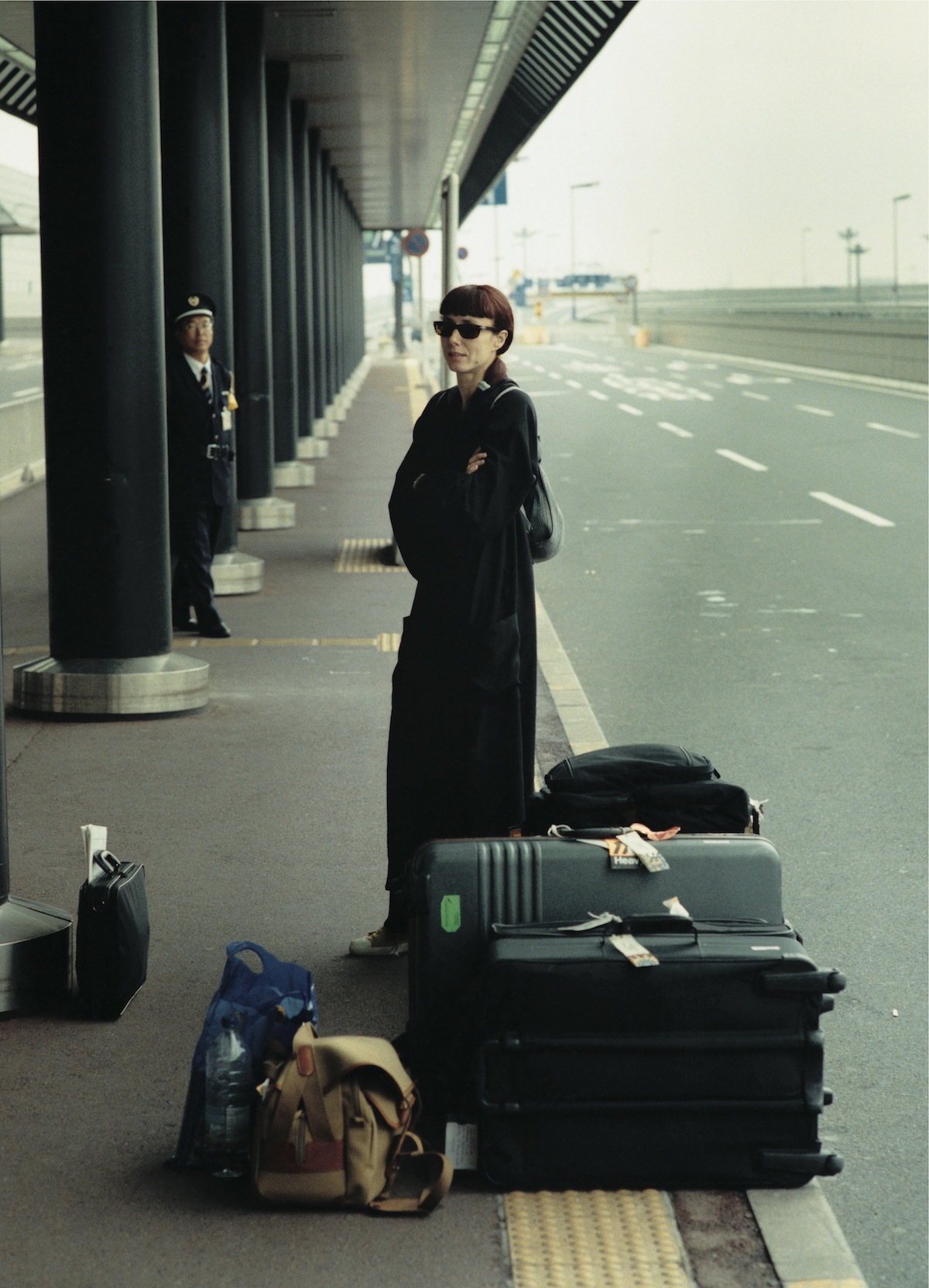 I’ve experienced earthquakes in Japan many times, and they're quite scary, you can’t get used to them, but the Japanese live with them, I don’t know how. A tsunami, though - that's something else. It was just one shock after another. And you feel powerless. I've got to know a lot of people there, over many years. Friends who come to my shows, people who write on the website - I was trying to find out how their families were. They told me, we’re all right.
I’ve experienced earthquakes in Japan many times, and they're quite scary, you can’t get used to them, but the Japanese live with them, I don’t know how. A tsunami, though - that's something else. It was just one shock after another. And you feel powerless. I've got to know a lot of people there, over many years. Friends who come to my shows, people who write on the website - I was trying to find out how their families were. They told me, we’re all right.
You’ve performed in Sendai?
Yes, regularly. When I'm on tour in Japan I often go there. (Pictured, Guillem at Tokyo Airport, © Gilles Tapie/Invitation)
Now you're going out there, so what’s the state of Sendai now?
I don’t know yet. I’m going to be performing two charity shows in that area for people who are homeless. Not in Sendai itself, there are two other towns close by, where I’ll be. But Sendai wasn’t too much touched, it was the coastal area that was destroyed.
Have you been back there since?
No.
Are you curious? Will you travel around there to see what’s going on now?
If I have time I will, but I’m going to be in Tokyo first, then after that it’s travelling, performance, travelling, performance, so there's not going to be a lot of time available. Also the Japanese are so efficient that I guess they’ve cleaned up a good part of it and it’s not as traumatised as it was. No, I’ll see what I can in the time.
When did you first go to Japan?
It was my first trip abroad - it was with the Paris Opera School, my last year, I think I was 16. It was the first time the Paris Opera School had been invited by the NBS [the Japan Performing Arts Foundation], which is the foundation that invites artists to Japan. So we did a few demonstrations and classes on stage, and we performed Les deux pigeons. It was a shock for all of us, for the audience and for me. Japan is another world, you see things you’ve never seen, you eat things you couldn't even think of eating...
Though we were kids, I already knew about performing on stage, because we would do shows every season, mostly in the Opéra Comique, which is a little replica of the Paris Opéra, a tiny, tiny place. But when we arrived in Japan we performed in the NHK Hall, Tokyo, which is enormous! [It has more than 3,600 seats.] By the second or third show you start to get the feel of it, you know there is an appointment that you should not miss with the audience. Then you meet the audience afterwards, and you see their happiness, their reaction - it's almost an over-reaction, more than you’re used to. We used to have a few people waiting at the stage door in Paris but not that way.
They scream? Like you’re The Beatles?
Yes! They scream, they were really, really enthusiastic. It was totally new to me. And powerful to encounter.
And did Japan make a visual impact on you?
Yes, the visual impact is very strong. I hadn’t imagined Tokyo would be like this, it’s full of motorways, tubes, buildings, it’s quite an ugly town in a way, when you first see it, but so, so modern. And then you see a woman in a kimono. You take impressions... That... And that... And that.
Favourite things: Taizo Kuroda pottery, bamboos, kimono, pictured on sylvieguillem.com
![]()
And you look into the windows of restaurants and it’s a way of life you couldn’t have imagined. I mean, in a good way, because it wasn’t like, “oh, it’s better at home”. It was just eyes like that... [eyes wide]. And with that first trip came my wish to know more about the place.
Do you feel that the Japanese people particularly need theatre, art, as distraction now from the awful daily conditions?
I guess that for every population anywhere in the world, art has been something to escape to, to help them to bear daily life - even when there hasn't been such a dramatic event. But it is special for the Japanese. When people say to you, “I’d give you a part of my life so that you can keep on dancing,” that’s a very powerful thing to say. Yet you always think that the Japanese are distant, don’t express their emotions - that’s wrong. When they actually say to you, “You changed my life,” you feel the responsibility, the importance of what you do. It may seem something light, superficial, to do a show, costumes, dancing, all that - but it means much more than that to people. Art really can change you.
Last time I went to see something at the Southbank Centre I saw Tristan and Isolde with video by Bill Viola - I can say that seeing that show changed my life. It's like when you see a field of vineyards and a beautiful little castle in St Emilion - you think, that’s what human beings do so well. You accumulate impressions, sensations, that make you different, make you see differently. The technological experience of Bill Viola’s video, the music, the sound, the voices, the musicians, it all came together in one magical, exceptional thing. It's rare to have that sense of something really beautiful.
Watch a trailer for that production, with Peter Sellars, Esa-Pekka Salonen and Bill Viola
How do you find the Japanese in contrast with Europeans? This is a small set of islands packed with people, so presumably that must affect their character.
There's a refinement in the way in which people deal with each other, which I think they're proud of. It’s a way of doing things, of being with others, of presenting visual things - all those details maybe make you feel that everything is intimate. Everything is about the pleasure of the other person, the fact that you should not bother the other. And this is very new when you arrive from a Latin place like France, where it is [elbows jab] me first. And the Japanese are the opposite: “Sorry I disturbed you.” And nothing is too beautiful, nothing is too respectful.
How does a person like you, a very Western woman, running your career very independently, appear there? You’re not remotely like the Crown Prince’s wife, who had a career and was asked to stop it in order to become the Imperial wife. Does the culture exist for a Japanese Guillem?
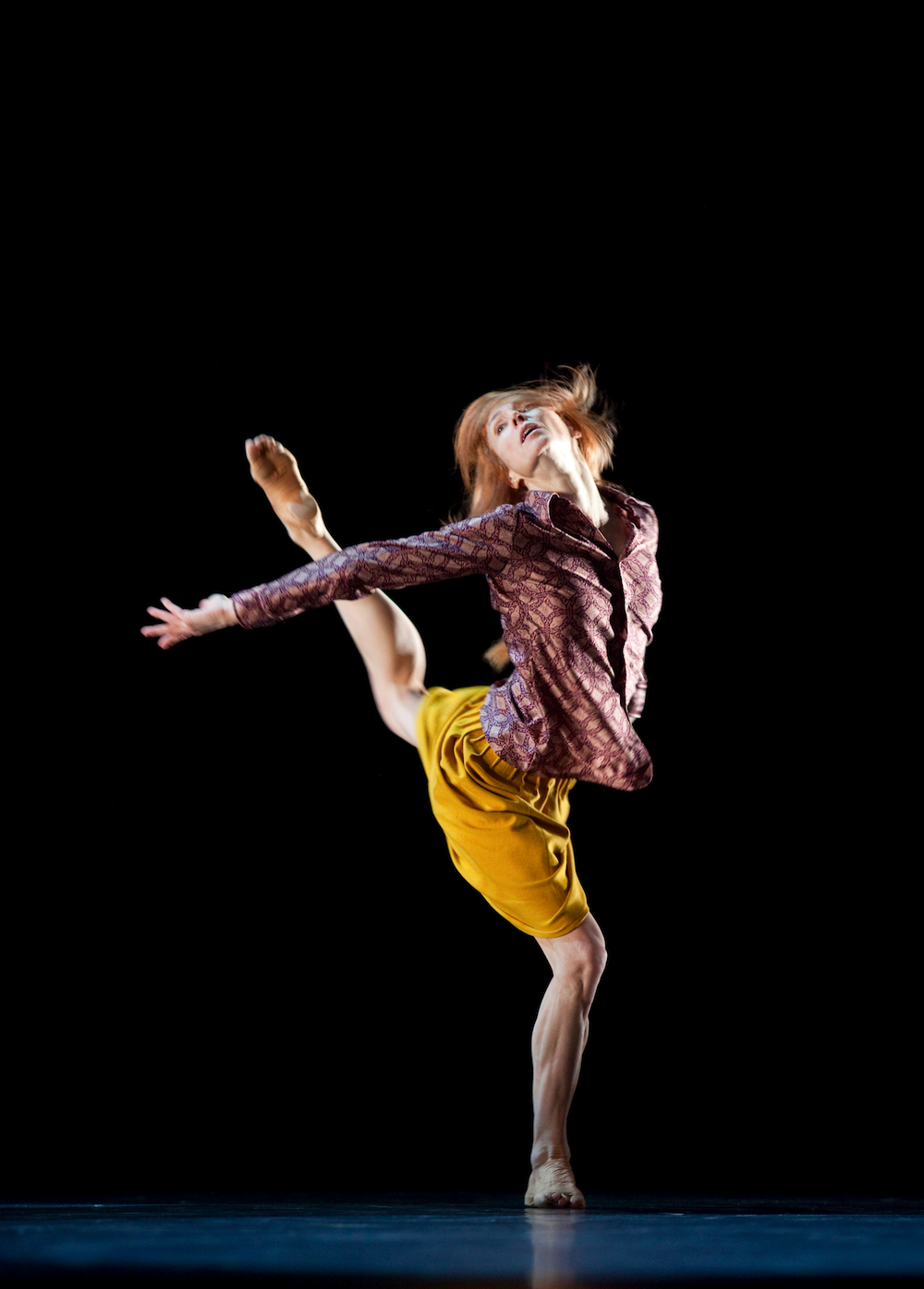 It’s a country that I like and love as me, from my own background. Of course it would be different if I was Japanese. But you know, there are a lot of women doing a lot of things in Japan, CEOs, designers, singers, maybe more than appears to us in the West. But as for me being a role model for Japanese women, I can’t know that. (Pictured, Guillem in Mats Ek's Bye, on the 6000 Miles Away programme © Bill Cooper/Sadler's Wells.)
It’s a country that I like and love as me, from my own background. Of course it would be different if I was Japanese. But you know, there are a lot of women doing a lot of things in Japan, CEOs, designers, singers, maybe more than appears to us in the West. But as for me being a role model for Japanese women, I can’t know that. (Pictured, Guillem in Mats Ek's Bye, on the 6000 Miles Away programme © Bill Cooper/Sadler's Wells.)
What is the composition of the audience in Japan for you? Genders, ages.
I would say more women, and all ages, young, middle-aged, older. A few men.
I remember [the Royal Ballet principal dancer] Stuart Cassidy saying about going to K Ballet in Japan from the Royal Ballet, he’d never been looked at by so many women before!
Yes, but you do have more young men with their girlfriends now. And I guess it depends on the show you present.
Have you been more to Japan than any other country?
Yes, certainly. Since my first visit with the school I've been there almost every year, sometimes three times a year. One year I spent five months in Japan. When I arrive, the hotel manager always says, “Welcome home!” Yes, I feel very good to be there. Each time I go there is more to discover. We're very lucky that for 20 years now we’ve had the same interpreter, who loves her country, but she says, “It’s so good to be with you because you help me discover my own country.”
Outsiders sometimes find better questions.
And I think perhaps especially for them. Of course there is a section of the audience that likes the tutu and the glittery things that the West brought, which was completely the opposite of what they did. For them, it is more a sensitivity to shadows, they prefer the refined. I think they were very attracted at the beginning when we put gold and jewels under the light, because it was the opposite of what they are, but then gradually they discovered things that speak more to them. I think that’s why they liked Maurice Béjart a lot, certain dance pieces of his that were more graphic, that used the imagination, the Buddhist way of approaching things - not like, say, here’s The Sleeping Beauty, here is gold, costumes, story, easy access. And they like Jiri Kylian... oh, I know I shouldn’t talk about Kylian here because all the critics hate Kylian! And they hate Béjart here! But I think the Japanese are touched by that kind of thing, they can see the poetry in it, the esthétisme, the very touching relationship between the choreography and music. And they started to change, to evolve their taste away from the classical Western style.
Watch Guillem and Russell Maliphant in an excerpt from Push
It changes you to know how different things can be, that people can live in small spaces being attentive to each other, paying respect. You see it works
How has Japan changed you?
It changes you to know how different things can be, to know that people can live in small spaces being attentive to each other, paying respect, keeping their surroundings clean. You see it works, it’s not imagined, it’s not a utopia - it just works. And it changes your taste for simplicity. When you get bitten by their refinement, whether in architecture or in gardening or food or poetry or the kimono, or in their traditions, all of that is kind of, wow!
And they are refined in their approach to each other, and in their sense of honour and taking responsibility. It’s so impressive to see this working, and they make it work beautifully, not in a militaristic way. They can be crazy, they can be inventive. They just do respect the other person, when they invite them to a meal or when they invite them to work. And that’s a basic thing for human beings, that you are not alone on the planet. You want to be loved. It’s not true when people say, “I don’t care if no one loves me.” So why not arrange society to bring that basic... well, love might be an excessive word, but bring that kind of respect to it?
The restoration of the country requires a great communal love from top to bottom of the society.
You’ve seen their solidarity? Only the Japanese, I think, would show this kind of solidarity.
I was thinking of the refusal of the nuclear company to accept responsibility for the Fukushima meltdowns...
Well, they’re against that, of course - but business is business. There is corruption in Japan, certainly, but overall the culture is different, they take responsibility. It must be the only country where somebody actually took responsibility for the state. [Prime Minister Naoto Kan resigned last month.]
This nuclear business worries you.
Yes, I’m completely against nuclear. I’m sure there are other solutions.
But what else can they use for their energy? They have no oil, coal or gas.
They have the sea around them, and also they are very smart, they are an inventive people. Also, though they are a society that consumes a lot of electricity, it's possible to save it. This is a global problem, not just for the Japanese. People don't need so much electricity. Look at this room: full sun but there’s a lamp on. How many people switch off when they leave a room?
You do that?
Yes, of course.
And do you still cycle around London?
I cycle wherever I can, and I take the train a lot.
You have an amazingly busy schedule for the next few months, in Japan and elsewhere.
I’m doing several programmes in Japan. First a charity gala, and two Béjart pieces, La luna and Boléro, pieces that the Japanese really love. And four performances of Ashton’s Month in the Country, with Anthony Dowell as my husband and Massimo Murru. Then I have four shows of 6000 Miles Away, with Massimo. Then we’ll do a little tour with the Béjart pieces and two other charity galas. Then I come back to Tokyo to do Eonnagata [with Robert Lepage and Russell Maliphant].
That’s why I don’t expect to have much time to visit the countryside. I was just thinking, when am I going to get time to rehearse this or that? Because then I'm going to the Mariinsky, St Petersburg to do Push, and Vienna too. And then Singapore to do 6000 Miles Away, and then right away again Boléro and La luna, and Month in the Country and a bit of Manon. And then Sacred Monsters in January. Buh-buh-buh! That’s how it is!
Being a Star
You did MacMillan’s Manon in La Scala this year. How did it feel to dance classical ballet again?
It felt great! Very... light. I thought it might be hard work to return to it.
You might do more classical ballet again?
Yes, but not forever. It was a good chance to do it at La Scala - I had no problem coming back to it, I enjoyed it.
What struck me about how you did Manon at the Royal Ballet, say, a decade ago was that while some dancers take the dramatic approach, the narrative, the backstory, the climb out of the ghetto, you made her elemental, just a sort of happening - you played a girl who is a light that attracts men who ruin their lives. “It’s not my fault, it’s just me!”
She’s like Carmen, hein! She’s one of those! Exactly.
I remember being told something Kenneth MacMillan said, that he was fascinated by how certain girls attract people. Why one dancer has that power of attractiveness, but not the other four, even when they're all beautiful. Trying to understand the lightning that strikes. I thought, this is what Manon is, as you play her. One's seeing this girl who can’t help attracting people.
Yes, you’re right. It’s a light. You even see it in the street, people with that quality.
Did you ever feel as a kid that you attracted people? Or did you work at it?
Non, you can’t work at it. You can’t. I always remember... and I won’t say names, but in many places, at the Royal Ballet or the Paris Opéra, wherever, there are people who have everything. Physically they are built for dance, they have strength, they have technique, they are even, you know [hand drawn down face], beautiful. But on stage you don’t see them, you don’t remember them. They go on, it’s nice, they pass, it’s as if they hadn’t existed.
It isn't fair, in a way. What is it that makes others who might be a bit less beautiful, this man, that girl, have a light inside? Is it the way they think, the way they are, is it their soul? We don’t know. But it makes that difference.
I had a friend at a show with me once who said, “Who's dancing this ballet?” I said to him, it’s this guy, we call him Mr Invisible. My friend says, “You're exaggerating, how mean - he’s beautiful, he dances well!” Five minutes later, the man comes back on stage, and my friend says, “Who’s that?” Literally! I said, I told you so...
And that’s not something you got taught as a student - learning about switching on that light?
No, you really can’t learn it. You don’t even know what it is. There’s no recipe.
No, but there are some performers who are invisible at 25 but at 40 they’ve become very visible.
Maybe it’s because something changed in their lives. Maybe they just learned to put certain monsters aside and discovered something about themselves. Maybe they had it anyway.
How many people have it? One in 20, one in 30?
Zero point zero zero zero one! It’s very, very rare. You know, yourself. How many times you’ve been to see things - they’ve been nice things [shrug], like seeing a nice bit of architecture or painting. And then suddenly you go, "Oh, wow!" How many times?
I think that’s partly my fault, that when I’m watching I’m bringing my own baggage. I don’t know exactly why with one person I’m always interested in what they’re doing, and with another I’m praying, oh, please surprise me. That’s my fault, because I’ve built up expectations.
Yes, I understand this - you have reference points because you've seen a lot, it’s your job. But still there was once a first impression you had. And there are also things you see that aren't from your job, but in the street or in life. Your eyes are always picking up things that become references too. And it’s rare to see that special quality.
Even when people like you, you always have to surprise them too. And maybe they're even more difficult
And it’s cruel too. Because even if it didn’t work for me, it may have worked for others.
Yes, and also some people are allergic to some performers. You know there is something else behind it. There’s no proper analysis, they have already decided what it will be like before they arrive.
Well, you can’t have had too many occasions of critics not liking your work...
Look hard! Some people are allergic to what I do.
Maybe it’s good for you occasionally to have a few people who don’t like you, because so many do.
It doesn’t make any difference, because even with the people who like you, you always have to surprise them too. And maybe they are even more difficult. They know you, they like you, and they want more and more. The people who don’t like you, that’s not something you have to win.
Watch Guillem performing the opening of Béjart's Bolero
Exposure
I was looking at your cute website, the little squares and games and lots of pictures that you took, and at your huge book, Invitation. One thing struck me: that you don’t do a lot of verbal interviews but you’re very much photographed. You've had a camera on you all the time from an early age.
Well, to start with I didn’t like it. I still don’t like doing a "shoot", because there’s something fake about that. But when we were doing the book or the films it became part of my life, because 99.9 per cent of the pictures were Gilles’s, so I had no fear, complete trust, it was him looking at me. I didn’t have to think that I needed to “look like” something. With the camera I learned how to trust the guy who was there, and Françoise the réalisatrice. I just forgot about them, really. You knew they weren't going to try to trap you somewhere. It was witness of whatever happened. It existed and they filmed it.
What are you worried about when you're photographed?
There are pictures that don’t show, I won’t say, the “truth”, but I mean, the “reality”. Pictures that allow people to see something that doesn’t exist.
Is it about your line?
Of course the esthétisme must be respected, because it’s something I have worked really hard for a long time to present. It would be stupid of me to let out a picture that goes completely against all the work I've done off stage. And the quality of the picture is important - what we do is very visual so I’ve learned to become quite critical. It’s also a matter of respect, what do you decide to publish? Sometimes you can do better.
So it’s not a question of vanity.
It’s a question of truth. Of what is reality, what is there. When somebody's taking a picture of me there is always a question mark between me and them because I don’t know, I have some fear, I have some doubt, and it will show. When I take self-portraits I know exactly who I see there, and when I press the button what the picture will be. And that makes a huge, huge difference.
It is not just about being a pretty face, which I am not, non, or otherwise I would be a model and I am not a model. I have a lot of things about me that I don’t like, and I can see that in a picture. So it isn’t about the picture being always nice, even aesthetically. Mainly it’s about the life in the picture. There is life, or there is not. It is a real picture, or it is not.
At the Royal Ballet there was a time when you didn’t have any pictures being issued at all. There were production shots without Sylvie.
First, the problem was with the press office. They didn’t want to upset the newspapers and photographer by asking for me to have the right to choose the pictures. They would send me their choice, and within the choice I got to say yes, yes, no, no. But they became so afraid of upsetting the newspapers that they would say, she doesn’t want her picture taken. So it was easy to assume that it had to be the boyfriend who did her pictures. It was childish, but it was easy for people to accept. And now most of the photographers I talk to find it normal for me to say, no, not that one.
Pictured below: Guillem with William Trevitt and Michael Nunn in Broken Fall © Gilles Tapie/Invitation
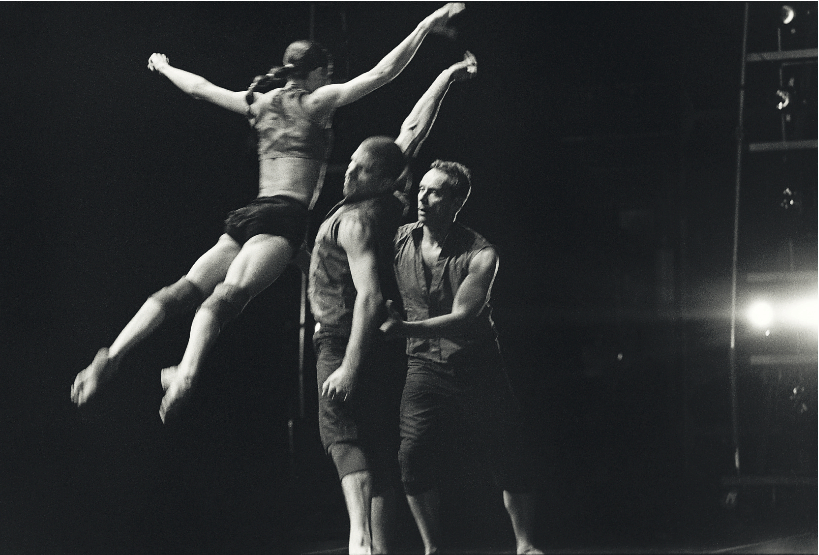
Advice
You have very clear views - do you have any interest in teaching?
The ones who want to be taught, yes. The others, non.
Do you do any? You seem so exact in what you require.
I don’t do it in any organised way, like coaching or masterclasses, I do it more instinctively, if I’m asked, if I’m visiting a company or something. But do they want to learn? That’s always the question. When I was at the Royal Ballet, sometimes I would see things, I'd go to the person and say, you should maybe think about this or that. And afterwards you realised that it didn’t really matter to them - even the opposite might be better. OK, maybe it was a wrong decision for me to go and talk to them. I might be not the right person for them.
If someone wants some advice, I am available. But I do wonder if people want it
People who come to me, that’s a different matter, because they want to learn. There was a girl in the corps de ballet who left, Cindy Jourdain. They don’t have to be talking about a big performance, it might just be something they want help with to do it well. I also help - if they want - a few people in the Paris Opéra Ballet. I'm available. If someone wants to have some advice, I am available. But I do wonder if people want it!
Have you lost a bit of faith in the ballet world?
It’s not the ballet world, it’s a representation of society in general. It’s a micro-society. To find people who have the capability to understand is quite minimal. When I did my production of Giselle in Helsinki and La Scala, I spent hours, days, weeks, full out, I told them everything I knew. Not just my own experience but what I could see could work for them, so it was really personalised. And then I found myself repeating the same things, because it was not getting in - or it was getting in and then getting out very fast.
If they can’t take it on board, they will not be able to evolve because you have to integrate something to make it a tool for something else. But no - people were thinking, you give it to me, I swallow it, then out it goes. It was not something they wanted to make them richer or more interested in what they do. Society is a bit like this...
You sound like an idealist. Idealists keep getting hurt!
It is fantastic to believe in human beings. Well, it would be. But it’s not human!
You say on your website that you dislike “l’homme et sa bêtise”, rather than “l’homme et sa...”
"L’homme et son intélligence!” Because there are more stupid people than intelligent people to deal with. In our time, mediocrity is on top, that's what is immediately under the light.
But you always knew that?
Not so much. It was not so much then. Look at the world of dance. In France, when you were an étoile, it was a glamorous thing, like being a movie star. Then they started to scratch away at the glamour, because it’s good for people in the street not to be so starstruck, and it became banal. At the time I was in the Paris Opéra Ballet, you had Rudolf Nureyev, Baryshnikov, you had people to look up to. And now there are people put on top who you don’t even want to look at. You can’t look up to them.
I don’t know how that’s to be solved. I worry about why young people don’t write about dance. It shouldn’t be people of my age. It’s a young people’s art form.
Because it’s not exciting enough? It’s boring? What is it?
I wonder if it’s that dance has become frightening to people. The press releases now say that you need three science A levels to understand it, or a degree in comparative philosophy.
Just heart.
Yes, feelings, a heart, eyes. But I think the amount of work involved in dance also frightens people now. They don’t understand that this [I point at her foot] didn’t come in 15 months' quick study.
That’s for sure. And the pride, the pride of working well. This they have in Japan. They are so proud of what they do. Whether it’s something glamorous, or economically phenomenal, or sweeping the floor, they’ll do it well - they take a personal pride in it.
Passions
Well, Britain is good at splashing things around, in a shallow way... You mention in your likes and dislikes your liking for “voitures décapotables Anglaises” - soft-top English cars.
I like the AC Cobra. It has no top at all, and it looks kind of cute but it’s a very nice sports car, not a toy. It goes really fast, though I don’t like to go fast. No, I don’t have one! But my favourite car isn’t an English car - it’s the Fiat 500 Topolino. That’s my car!
Pictured below, the AC Cobra and the Fiat Topolino 1937

You don’t like going fast?
Non! It’s not really a big thing in my life, but I can appreciate beautiful cars. Again, when you look down the street now you don’t see any difference, they all look the same. When you had the French Citroën DS, the Mercedes Papillon, Jaguar E-type, they had character. Now...
But I'm afraid that’s partly the Japanese influence - Honda, Toyota, Nissan.
Well, they make them useful instead. I have a Lexus, which is a Toyota.
It’s the hybrid? You got it because it was a green car?
Yes, it’s very difficult to find an efficient green car.
There is a hydrogen car I think Honda made which they’ve been testing in LA, its emissions are entirely water.
Yes, and there’s another with compressed air. Can you imagine, making a car work on air? No pollution at all!
Then all the fuel stations have to come up with all the different refill points.
Why not? They should change. They won’t change because lobbies and business are behind them. There was a film that a lot of people told me was fantastic, called Who Killed the Electric Car? - a James Bond story, almost. Industrial interests were doing everything they could to stop the electric car. And you know where we’re going without this - we’re heading for the wall. And these people, they’re having children, what are they thinking?
I have a feeling you should be in politics, somehow... In a sense your galas for Japan are political. You’ve got other dancers and musicians there drawing attention to the country’s devastation and the need for the world to help restore it. Do you sometimes, as artists, feel you need to make a connection with everyday life in that very direct way?
No. Life is happening for everybody. If you don’t want to see it, that’s a problem for you, but I see life, I don’t need to go into the subway every day to see it. Maybe spending time in the theatre, with people waiting for you or people taking care of you, seems different, but you would really have to be blind not to see real life.
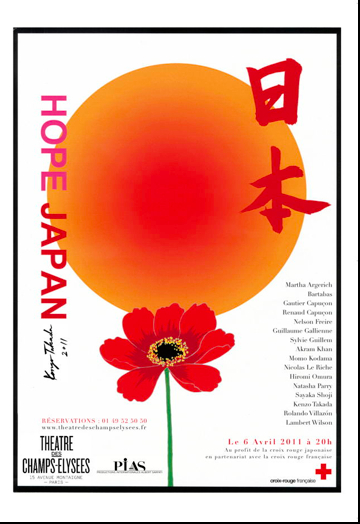 Those galas were to show that you care. We were able to organise the Paris gala something like two weeks after the earthquake in the Théâtre des Champs-Elysées - a Japanese musician was supposed to come, but he didn’t, so there was a date free [See gala poster (pictured): Pianist Martha Argerich and opera singer Rolando Villazón were among musical participants]. But when I tried here in London to contact singers and musicians to do a gala, they were not free. I must say, I was quite shocked. Not the dancers, they were all ready, it was the others. What happened to compassion? I wish I could do more, not only about that. Japan was special for me, as I say, because it’s almost a second home for me. I appreciate a lot of things about it, even if there are things I don’t appreciate at all.
Those galas were to show that you care. We were able to organise the Paris gala something like two weeks after the earthquake in the Théâtre des Champs-Elysées - a Japanese musician was supposed to come, but he didn’t, so there was a date free [See gala poster (pictured): Pianist Martha Argerich and opera singer Rolando Villazón were among musical participants]. But when I tried here in London to contact singers and musicians to do a gala, they were not free. I must say, I was quite shocked. Not the dancers, they were all ready, it was the others. What happened to compassion? I wish I could do more, not only about that. Japan was special for me, as I say, because it’s almost a second home for me. I appreciate a lot of things about it, even if there are things I don’t appreciate at all.
But there are causes I would like to be more involved in, and I don’t know how to be. Something that has been on my mind a long time now is infibulation, the circumcision of little girls. It's the most terrible thing you can do to a human being, the most disrespectful, the most painful, and it goes on and on. Firstly, many of them die from it. And when they don't they live a terrible life, all for some sort of tradition, the pleasure of a man. It's incomprehensible. It’s not my world and I don’t know enough about it to be involved in it, but I wish I could. Because it is still going on, and we are in the 21st century, and it’s not acceptable.
I’m involved also with animal conservation, to my own level, not like Brigitte Bardot. I support them with money or talking or wearing a T-shirt like this... this one I'm wearing is for Sea Shepherd, protecting the whales, dolphins and tuna.
You’ve seen a whale?
From a helicopter. That’s something I don’t like about Japan. They haven’t seen this T-shirt yet! [chuckles] It’s not the time for it. But I tell them what I think. When a restaurant offers me whalemeat I don’t go back to that restaurant.
But Japan is a pretty special country to me, for all its faults. Please put aside any bitterness about them being a rich country so let them sort themselves out. They are just suffering - like you and me. They've lost what they had, in a shocking, terrible instant. There are still thousands of people living in two square metres in a village hall, and they've lost all their memories, their houses are gone, sometimes their family is gone. They need help.
Biography
Born 23 February 1965 in Paris
1976 Entered L’École de danse de l’Opéra de Paris
1981 Hired by Nureyev in the corps de ballet of the Paris Opera Ballet
1984 Promoted by Nureyev to top rank, étoile
1987 William Forsythe created in the middle somewhat elevated on her
1989 Joined the Royal Ballet as Principal Guest Artist, stays 17 years
Notable premieres include Forsythe’s Firstext, Ashton’s Marguerite et Armand (the first staging since Margot Fonteyn’s death), Russell Maliphant’s Broken Fall (with the Ballet Boyz); notable roles include Tudor’s Lilac Garden, MacMillan’s Manon and Juliet, Ashton’s A Month in the Country, Robbins’ The Concert
1994 Chevalier of the Legion of Honour (decorated by President Mitterrand)
1995 Made dance film Evidentia (including creations by Jonathan Burrows and Mats Ek)
1998 Staged Giselle with Finnish National Ballet and La Scala Ballet, Milan
1999 Officer of the French Order of Merit
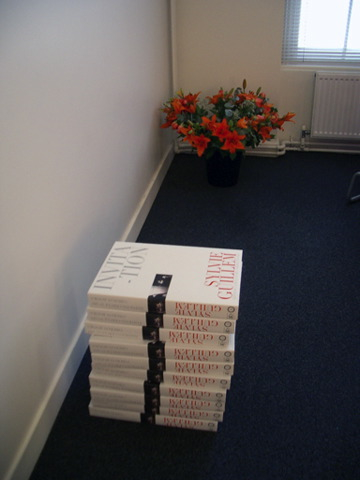 Creations for her include Maurice Béjart’s Sissi impératrice, Mats Ek’s Smoke and Wet Woman, Jonathan Burrows’s Blue Yellow, Russell Maliphant’s Broken Fall and Push, Akram Khan’s Sacred Monsters, Eonnagata with Robert Lepage. Other repertoire by Mary Wigman, Agnes de Mille.
Creations for her include Maurice Béjart’s Sissi impératrice, Mats Ek’s Smoke and Wet Woman, Jonathan Burrows’s Blue Yellow, Russell Maliphant’s Broken Fall and Push, Akram Khan’s Sacred Monsters, Eonnagata with Robert Lepage. Other repertoire by Mary Wigman, Agnes de Mille.
2003 Honorary CBE
2005 Published Invitation, an autobiographical photographic book with her husband, photographer Gilles Tapie (picture © sylvieguillem.com)
2009 Filmed On the Edge (Sur le fil), about two years of Japan tours with Swan Lake and modern dance, including the creation of Eonnagata
- Sylvie Guillem’s website for further tour information: Push with Russell Maliphant in St Petersburg 3 & 4 October; San Poelten, Austria, Push and 6000 Miles Away 8-15 October; Hope Japan tour with Tokyo Ballet and Eonnagata with Robert Lepage and Russell Maliphant 19 October-20 November (charity galas Tokyo 19 October, Iwate 31 October, Fukushima 1 November); Sacred Monsters with Akram Khan in Paris, 5-9 January 2012 and Belgrade, Serbia, 28-29 March: 6000 Miles Away with Nicolas Le Riche at The Hague 26-27 January, Paris 15-22 March, Geneva 12 April, Zurich 19-20 April
- Hope Japan charity website
- Gilles Tapie's photography website
Buy
Share this article
Add comment
The future of Arts Journalism
You can stop theartsdesk.com closing!
We urgently need financing to survive. Our fundraising drive has thus far raised £33,000 but we need to reach £100,000 or we will be forced to close. Please contribute here: https://gofund.me/c3f6033d
And if you can forward this information to anyone who might assist, we’d be grateful.

Subscribe to theartsdesk.com
Thank you for continuing to read our work on theartsdesk.com. For unlimited access to every article in its entirety, including our archive of more than 15,000 pieces, we're asking for £5 per month or £40 per year. We feel it's a very good deal, and hope you do too.
To take a subscription now simply click here.
And if you're looking for that extra gift for a friend or family member, why not treat them to a theartsdesk.com gift subscription?
more Dance
 Help to give theartsdesk a future!
Support our GoFundMe appeal
Help to give theartsdesk a future!
Support our GoFundMe appeal
 The Forsythe Programme, English National Ballet review - brains, beauty and bravura
Once again the veteran choreographer and maverick William Forsythe raises ENB's game
The Forsythe Programme, English National Ballet review - brains, beauty and bravura
Once again the veteran choreographer and maverick William Forsythe raises ENB's game
 Sad Book, Hackney Empire review - What we feel, what we show, and the many ways we deal with sadness
A book about navigating grief feeds into unusual and compelling dance theatre
Sad Book, Hackney Empire review - What we feel, what we show, and the many ways we deal with sadness
A book about navigating grief feeds into unusual and compelling dance theatre
 Balanchine: Three Signature Works, Royal Ballet review - exuberant, joyful, exhilarating
A triumphant triple bill
Balanchine: Three Signature Works, Royal Ballet review - exuberant, joyful, exhilarating
A triumphant triple bill
 Romeo and Juliet, Royal Ballet review - Shakespeare without the words, with music to die for
Kenneth MacMillan's first and best-loved masterpiece turns 60
Romeo and Juliet, Royal Ballet review - Shakespeare without the words, with music to die for
Kenneth MacMillan's first and best-loved masterpiece turns 60
 Vollmond, Tanztheater Wuppertal Pina Bausch + Terrain Boris Charmatz, Sadler's Wells review - clunkily-named company shows its lighter side
A new generation of dancers brings zest, humour and playfulness to late Bausch
Vollmond, Tanztheater Wuppertal Pina Bausch + Terrain Boris Charmatz, Sadler's Wells review - clunkily-named company shows its lighter side
A new generation of dancers brings zest, humour and playfulness to late Bausch
 Phaedra + Minotaur, Royal Ballet and Opera, Linbury Theatre review - a double dose of Greek myth
Opera and dance companies share a theme in this terse but affecting double bill
Phaedra + Minotaur, Royal Ballet and Opera, Linbury Theatre review - a double dose of Greek myth
Opera and dance companies share a theme in this terse but affecting double bill
 Onegin, Royal Ballet review - a poignant lesson about the perils of youth
John Cranko was the greatest choreographer British ballet never had. His masterpiece is now 60 years old
Onegin, Royal Ballet review - a poignant lesson about the perils of youth
John Cranko was the greatest choreographer British ballet never had. His masterpiece is now 60 years old
 Northern Ballet: Three Short Ballets, Linbury Theatre review - thrilling dancing in a mix of styles
The Leeds-based company act as impressively as they dance
Northern Ballet: Three Short Ballets, Linbury Theatre review - thrilling dancing in a mix of styles
The Leeds-based company act as impressively as they dance
 Best of 2024: Dance
It was a year for visiting past glories, but not for new ones
Best of 2024: Dance
It was a year for visiting past glories, but not for new ones
 Nutcracker, English National Ballet, Coliseum review - Tchaikovsky and his sweet tooth rule supreme
New production's music, sweets, and hordes of exuberant children make this a hot ticket
Nutcracker, English National Ballet, Coliseum review - Tchaikovsky and his sweet tooth rule supreme
New production's music, sweets, and hordes of exuberant children make this a hot ticket

Comments
We look forward to seeing her
It was such a pleasure to